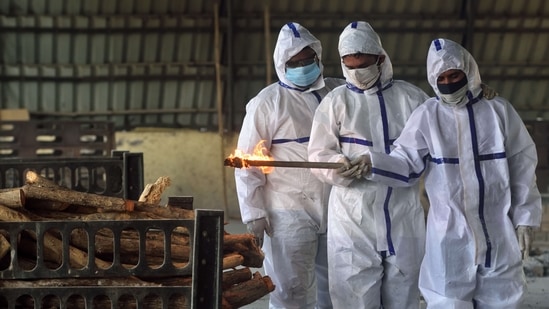Counting deaths in India is difficult
The current data architecture leaves gaps. Conduct large-scale household-level demographic surveys to ascertain excess deaths
Covid-19 has wrecked lives, devastated families, and destroyed livelihoods. An inquiry into the excess deaths due to the pandemic is, therefore, an important issue that needs redressal. The commonly used methodology of quantifying excess deaths based on India’s civil registry system (CRS), however, is not suited to address this. Any analysis based on it is likely to be misleading. The stark reality of India’s data system is that all deaths are still not accounted for; they are estimated based on demographic surveys.

Two critical issues merit consideration. First, historically, CRS is not the source of estimates of deaths at the national, state, or city level for three important reasons. One, not all deaths in India are registered (primarily of women and those residing in rural areas); two, registered deaths are not necessarily domiciliary, that is, place of death could be different from where a person typically resides; and three, deaths, if registered at all, are not reported promptly, a large number of registrations happen after the stipulated 21-day period, and, in some cases, beyond a year.
The primary source of annual estimates of deaths at the national and state level is the sample registration system (SRS). This is a large-scale demographic survey conducted annually by the Office of the Registrar General in India. The sample consists of 8,847 units (4,961 rural and 3,886 urban). A rural unit is a village or a segment of it if the village population exceeds 2,000. An urban sample unit is a census enumeration block with a population ranging from 750 to 1,000. Overall, the sample covers approximately 8.1 million people across all states and Union Territories.
SRS and CRS differ significantly in their estimates of the national- and state-level deaths and their estimates of excess deaths. This is best illustrated by looking at the data. In 2019, the registered number of deaths in India (under CRS) was 7,641,076.
However, the average registered deaths for the last four years (2015-18) was 6,507,832. Based on this, one would have concluded that there were more than 1.1 million excess deaths in India in 2019. (Incidentally, this is almost three times larger than the official Covid-19-related deaths in India). This conclusion would be erroneous because SRS data for the same time period reveals that estimated deaths declined marginally from 8,317,732 to 8,293,368.
What is true at the national level looks even starker at the state level. For example, in Madhya Pradesh (a state with more than 80 million people), the registered number of deaths based on CRS in 2019 was 493,328; however, the average registered deaths in the previous four years (2015-18) was 361,198. Once again, the commonly drawn but erroneous implication from this would be that there were approximately 130,000 excess deaths in MP in 2019. (This is 12 times more than the official Covid deaths reported by MP). During the same time period, the estimated deaths from SRS report a decline. So CRS, which is being commonly used by the media, is not a reliable source for quantifying excess deaths from Covid-19 in India.
Increased emphasis on digitisation of birth and death registrations since 2015 has led to an exponential increase in registered deaths while estimated deaths, as one would expect, have either declined marginally or remained approximately the same almost everywhere. Death registrations have been rising over time, from 66% (2011) to 75% (2015). The speed nearly doubled from 2015 onwards, leading to 92% registrations by 2019. Therefore, it is ironic that the government, which is pushing for higher registration of deaths, stands accused of hiding the number of deaths.
Second, the level of registration, which is the ratio of registered deaths from CRS to the estimated deaths from SRS, is not uniform across the country and over time. It varied widely from 21% in Manipur to 463% in Chandigarh in 2019. There are several possible reasons for this, perhaps the most important being that people from states with inadequate health facilities (typically rural) travel to regions with better facilities located primarily in urban areas. In some cases, this might result in a casualty, which is registered where it happens and not where the person resided. Therefore, CRS might report a higher incidence of death in one region versus a lower incidence in other areas.
In times of Covid-19, this is crucial because people with Covid-related health care needs flocked to urban centres with better health facilities, driving a significant spike in death registrations in those places. One might then erroneously conclude from CRS data that these urban centres with better health facilities were worst-affected than regions with inadequate facilities.
It is crucial to measure the effect of Covid on excess deaths everywhere. This is not only important from the perspective of public policy and improving access to health care but also because by counting the dead, a nation honours their memory. In India, CRS is not designed to quantify excess deaths.
Our best bet would be to conduct large-scale demographic surveys of randomly chosen households. We know from past international experience that household surveys give more accurate and most likely far higher estimates of excess deaths (more than 70 times in the case of Puerto Rico after Hurricane Marina) than the current official count. In India’s case, the current pandemic begs aggressive investment in robust data architecture. For this will not only improve policymaking but also honour the dead by first accounting for them.
Shamika Ravi is a non-resident senior fellow at Brookings Institution, and former member of the PM’s Economic Advisory Council
The views expressed are personal



